Mechanical Surface Treatment of Titanium Alloy Ti6Al4V Manufactured by Direct Metal Laser Sintering Using Laser Cavitation
Abstract
:1. Introduction
2. Materials and Methods
2.1. Torsion Test Specimens
2.2. LC by Pulsed Laser
2.3. Torsion Fatigue Test
2.4. Evaluation Methods of Surface Characteristics
3. Results and Discussions
3.1. Surface Treatment Behavior with Submerged Laser Irradiation
3.2. Effect of Submerged Laser Peening on Surface Morphologies
3.3. Residual Stress Evaluation by 2D Method and Composition Effect on Vickers Hardness
3.4. Improvement of Fatigue Life by Laser Cavitation
4. Conclusions
- (1)
- LP extends the fatigue life of AM Ti6Al4V, as indicated by the results of the torsional fatigue tests. The main reasons are the introduction of compressive residual stress and surface hardening. At τa = 460 MPa, the surface treatment with LP can extend the fatigue life of AM Ti6Al4V by 1.7 times. Furthermore, the LP was more effective at suppressing crack initiation than crack propagation;
- (2)
- In the residual stress measurement by the 2D method, the measurement time per frame affected the accuracy of the residual stress, which improved when the time per frame was more than 5 min/frame. The tensile residual stresses of σ11 = 182.8 ± 9.4 MPa in the circumferential direction and σ22 = 85.1 ± 11.3 MPa in the axial direction were changed to compressive residual stresses of σ11 = −80.7 ± 7.3 MPa and σ22 = −87.5 ± 8.8 MPa in the axial direction by the LP;
- (3)
- The Vickers hardness (HV) in the region below 60 μm from the surface was increased by about 106% on average by the LP. We attributed this increase in the hardness to the oxide film Ti4O5 formed by the thermal effect of the LP;
- (4)
- The LP acted as a mechanical alloying technique, melting and removing the remaining unmelted particles on the as-built Ti6Al4V specimens, and substantially reducing the surface roughness, which causes fatigue cracking.
Author Contributions
Funding
Data Availability Statement
Conflicts of Interest
References
- Abdulhameed, O.; Al-Ahmari, A.; Ameen, W.; Mian, S.H. Additive Manufacturing: Challenges, Trends, and Applications. Adv. Mech. Eng. 2019, 11, 1–27. [Google Scholar] [CrossRef] [Green Version]
- Alipour, S.; Nour, S.; Attari, S.M.; Mohajeri, M.; Kianersi, S.; Taromian, F.; Khalkhali, M.; Aninwene, G.E.; Tayebi, L. A Review on in Vitro/in Vivo Response of Additively Manufactured Ti-6Al-4V Alloy. J. Mater. Chem. B 2022, 10, 9479–9534. [Google Scholar] [CrossRef]
- Zhang, L.C.; Chen, L.Y. A Review on Biomedical Titanium Alloys: Recent Progress and Prospect. Adv. Eng. Mater. 2019, 21, 1801215. [Google Scholar] [CrossRef] [Green Version]
- Ghods, S.; Schur, R.; Montelione, A.; Schleusener, R.; Arola, D.D.; Ramulu, M. Importance of Build Design Parameters to the Fatigue Strength of Ti6Al4V in Electron Beam Melting Additive Manufacturing. Materials 2022, 15, 5617. [Google Scholar] [CrossRef]
- Nianwei, D.; Junxi, Z.; Yang, C.; Lai-Chang, Z. Heat Treatment Degrading the Corrosion Resistance of Selective Laser Melted Ti-6Al-4V Alloy. J. Electrochem. Soc. 2017, 164, C428. [Google Scholar] [CrossRef]
- Hollander, D.A.; von Walter, M.; Wirtz, T.; Sellei, R.; Schmidt-Rohlfing, B.; Paar, O.; Erli, H.J. Structural, Mechanical and in vitro Characterization of Individually Structured Ti-6Al-4V Produced by Direct Laser Forming. Biomaterials 2006, 27, 955–963. [Google Scholar] [CrossRef]
- Walker, K.F.; Liu, Q.; Brandt, M. Evaluation of Fatigue Crack Propagation Behaviour in Ti-6Al-4V Manufactured by Selective Laser Melting. Int. J. Fatigue 2017, 104, 302–308. [Google Scholar] [CrossRef]
- Fatemi, A.; Molaei, R.; Sharifimehr, S.; Phan, N.; Shamsaei, N. Multiaxial Fatigue Behavior of Wrought and Additive Manufactured Ti-6Al-4V Including Surface Finish Effect. Int. J. Fatigue 2017, 100, 347–366. [Google Scholar] [CrossRef]
- Tong, J.; Bowen, C.R.; Persson, J.; Plummer, A. Mechanical Properties of Titanium-based Ti-6Al-4V Alloys Manufactured by Powder Bed Additive Manufacture. Mater. Sci. Technol. 2017, 33, 138–148. [Google Scholar] [CrossRef] [Green Version]
- Zhang, H.Y.; Dong, D.K.; Su, S.P.; Chen, A. Experimental Study of Effect of Post Processing on Fracture Toughness and Fatigue Crack Growth Performance of Selective Laser Melting Ti-6Al-4V. Chin. J. Aeronaut. 2019, 32, 2383–2393. [Google Scholar] [CrossRef]
- Molaei, R.; Fatemi, A.; Sanaei, N.; Pegues, J.; Shamsaei, N.; Shao, S.; Li, P.; Warner, D.H.; Phan, N. Fatigue of Additive Manufactured Ti-6Al-4V, Part II: The Relationship between Microstructure, Material Cyclic Properties, and Component Performance. Int. J. Fatigue 2020, 132, 105363. [Google Scholar] [CrossRef]
- Pegues, J.W.; Shao, S.; Shamsaei, N.; Sanaei, N.; Fatemi, A.; Warner, D.H.; Li, P.; Phan, N. Fatigue of Additive Manufactured Ti-6Al-4V, Part I: The Effects of Powder Feedstock, Manufacturing, and Post-process Conditions on the Resulting Microstructure and Defects. Int. J. Fatigue 2020, 132, 105358. [Google Scholar] [CrossRef]
- Wang, P.; Sin, W.J.; Nai, M.L.S.; Wei, J. Effects of Processing Parameters on Surface Roughness of Additive Manufactured Ti-6Al-4V via Electron Beam Melting. Materials 2017, 10, 1121. [Google Scholar] [CrossRef] [Green Version]
- Gunther, J.; Leuders, S.; Koppa, P.; Troster, T.; Henkel, S.; Biermann, H.; Niendorf, T. On the Effect of Internal Channels and Surface Roughness on the High-cycle Fatigue Performance of Ti-6Al-4V Processed by SLM. Mater. Des. 2018, 143, 1–11. [Google Scholar] [CrossRef]
- Kahlin, M.; Ansell, H.; Moverare, J.J. Fatigue Behaviour of Notched Additive Manufactured Ti6Al4V with As-built Surfaces. Int. J. Fatigue 2017, 101, 51–60. [Google Scholar] [CrossRef]
- Soyama, H. Laser Cavitation Peening and Its Application for Improving the Fatigue Strength of Welded Parts. Metals 2021, 11, 531. [Google Scholar] [CrossRef]
- Soyama, H. Cavitation Peening: A Review. Metals 2020, 10, 270. [Google Scholar] [CrossRef] [Green Version]
- Soyama, H.; Korsunsky, A.M. A critical Comparative Review of Cavitation Peening and Other Surface Peening Methods. J. Mater. Process. Technol. 2022, 305, 117586. [Google Scholar] [CrossRef]
- Sano, Y.; Obata, M.; Kubo, T.; Mukai, N.; Yoda, M.; Masaki, K.; Ochi, Y. Retardation of Crack Initiation and Growth in Austenitic Stainless Steels by Laser Peening Without Protective Coating. Mater. Sci. Eng. A-Struct. Mater. Prop. Microstruct. Process. 2006, 417, 334–340. [Google Scholar] [CrossRef]
- Sano, Y. Quarter Century Development of Laser Peening without Coating. Metals 2020, 10, 152. [Google Scholar] [CrossRef]
- Gu, J.Y.; Luo, C.H.; Ma, P.C.A.; Xu, X.C.; Wu, Y.; Ren, X.D. Study on Processing and Strengthening Mechanisms of Mild Steel Subjected to Laser Cavitation Peening. Appl. Surf. Sci. 2021, 562, 150242. [Google Scholar] [CrossRef]
- Sasoh, A.; Watanabe, K.; Sano, Y.; Mukai, N. Behavior of Bubbles Induced by the Interaction of a Laser Pulse with a Metal Plate in Water. Appl. Phys. A-Mater. 2005, 80, 1497–1500. [Google Scholar] [CrossRef]
- Sano, Y.; Akita, K.; Sano, T. A Mechanism for Inducing Compressive Residual Stresses on a Surface by Laser Peening without Coating. Metals 2020, 10, 816. [Google Scholar] [CrossRef]
- Soyama, H.; Takeo, F. Effect of Various Peening Methods on the Fatigue Properties of Titanium Alloy Ti6Al4V Manufactured by Direct Metal Laser Sintering and Electron Beam Melting. Materials 2020, 13, 2216. [Google Scholar] [CrossRef]
- Nicholas, G.; Ali, F. Notched Fatigue Behavior and Stress Analysis Under Multiaxial States of Stress. Int. J. Fatigue 2014, 67, 2–14. [Google Scholar] [CrossRef]
- Berto, F.; Campagnolo, A.; Lazzarin, P. Fatigue Strength of Severely Notched Specimens Made of Ti-6Al-4V Under Multiaxial Loading. Fatigue Fract. Eng. Mater. Struct. 2015, 38, 503–517. [Google Scholar] [CrossRef] [Green Version]
- Soyama, H.; Kuji, C. Improving Effects of Cavitation Peening, Using a Pulsed Laser or a Cavitating Jet, and Shot Peening on the Fatigue Properties of Additively Manufactured Titanium Alloy Ti6Al4V. Surf. Coat. Technol. 2022, 451, 129047. [Google Scholar] [CrossRef]
- Khaing, M.W.; Fuh, J.Y.H.; Lu, L. Direct Metal Laser Sintering for Rapid Tooling: Processing and Characterisation of EOS Parts. J. Mater. Process. Technol. 2001, 113, 269–272. [Google Scholar] [CrossRef]
- Shibli, J.A.; Mangano, C.; Mangano, F.; Rodrigues, J.A.; Cassoni, A.; Bechara, K.; Ferreia, J.D.B.; Dottore, A.M.; Iezzi, G.; Piattelli, A. Bone-to-Implant Contact Around Immediately Loaded Direct Laser Metal-Forming Transitional Implants in Human Posterior Maxilla. J. Periodontol. 2013, 84, 732–737. [Google Scholar] [CrossRef]
- Gregolin, R.F. Development and Mechanical Characterization of a Mandibular Prosthesis in Titanium Alloy Fabricated by Direct Metal Laser Sintering (DMLS). In Proceedings of the 22nd International Congress of Mechanical Engineering (COBEM 2013), Ribeirão Preto, SP, Brazil, 3–7 November 2013. [Google Scholar]
- Theo, P.; Alexis, B.; Guilhem, M.; Jean-Yves, B.; Remy, D.; Eric, M. Effect of Build Orientation on the Fatigue Properties of As-built Electron Beam Melted Ti-6Al-4V Alloy. Int. J. Fatigue 2019, 118, 65–76. [Google Scholar] [CrossRef]
- Philipp, A.; Lauterborn, W. Cavitation Erosion by Single Laser-Produced Bubbles. J. Fluid Mech. 1998, 361, 75–116. [Google Scholar] [CrossRef]
- He, B.B. Two-Dimensional X-ray Diffraction; John Wiley & Sons, Inc.: Hoboken, NJ, USA, 2009; pp. 249–328. [Google Scholar]
- JSMS Committee on X-ray Study on Mechanical Behavior of Material. Standard Method for X-ray Stress Measurement; The Society of Materials Science: Kyoto, Japan, 2005; pp. 1–21. [Google Scholar]
- Soyama, H.; Kuji, C.; Kuriyagawa, T.; Chighizola, C.R.; Hill, M.R. Optimization of Residual Stress Measurement Conditions for a 2D Method Using X-ray Diffraction and Its Application for Stainless Steel Treated by Laser Cavitation Peening. Materials 2021, 14, 2772. [Google Scholar] [CrossRef]
- Soyama, H. Luminescence Intensity of Vortex Cavitation in a Venturi Tube Changing with Cavitation Number. Ultrason. Sonochem. 2021, 71, 105389. [Google Scholar] [CrossRef]
- Nakamura, M.; Takahashi, K.; Saito, Y. Effect of Shot and Laser Peening on Fatigue Strength of Additively Manufactured Aluminum Alloy with Rough Surfaces. J. Mater. Eng. Perform. 2022, 28, 3835–3843. [Google Scholar] [CrossRef]
- Aguado-Montero, S.; Navarro, C.; Vazquez, J.; Lasagni, F.; Slawik, S.; Dominguez, J. Fatigue Behaviour of PBF Additive Manufactured TI6AL4V Alloy After Shot and Laser Peening. Int. J. Fatigue 2022, 154, 106536. [Google Scholar] [CrossRef]
- Navarro, C.; Vazquez, J.; Dominguez, J.; Perinan, A.; Garcia, M.H.; Lasagni, F.; Bernarding, S.; Slawik, S.; Mucklich, F.; Boby, F.; et al. Effect of Surface Treatment on the Fatigue Strength of Additive Manufactured Ti6Al4V Alloy. Frat. Ed Integrita. Strutt. 2020, 53, 337–344. [Google Scholar] [CrossRef]
- Patterson, A.E.; Messimer, S.L.; Farrington, P.A. Overhanging Features and the SLM/DMLS Residual Stresses Problem: Review and Future Research Need. Technologies 2017, 5, 15. [Google Scholar] [CrossRef]
- Knowles, C.R.; Becker, T.H.; Tait, R.B. Residual Stress Measurements and Structural Integrity Implications for Selective Laser Melted TI-6AL-4V. S. Afr. J. Ind. Eng. 2012, 23, 119–129. [Google Scholar] [CrossRef] [Green Version]
- Mercelis, P.; Kruth, J.P. Residual Stresses in Selective Laser Sintering and Selective Laser Melting. Rapid Prototyp. J. 2006, 12, 254–265. [Google Scholar] [CrossRef]
- Crespo, L.; Hierro-Oliva, M.; Barriuso, S.; Vadillo-Rodriguez, V.; Montealegre, M.A.; Saldana, L.; Gomez-Barrena, E.; Gonzalez-Carrasco, J.L.; Gonzalez-Martin, M.L.; Vilaboa, N. On the Interactions of Human Bone Cells with Ti6Al4V Thermally Oxidized by Means of Laser Shock Processing. Biomed. Mater. 2016, 11, 015009. [Google Scholar] [CrossRef]
- Boller, C.; Seeger, T. Materials Data for Cyclic Loading. Part. D: Aluminium and Titanium Alloys; Materials Science Monograph, 42D; Elsevier: Amsterdam, The Netherlands, 1987; p. 127. [Google Scholar]
- Multigner, M.; Frutos, E.; Mera, C.L.; Chao, J.; Gonzalez-Carrasco, J.L. Interrogations on the Sub-surface Strain Hardening of Grit Blasted Ti-6Al-4V Alloy. Surf. Coat. Technol. 2009, 203, 2036–2040. [Google Scholar] [CrossRef]
- Lieblich, M.; Barriuso, S.; Multigner, M.; Gonzalez-Doncel, G.; Gonzalez-Carrasco, J.L. Thermal Oxidation of Medical Ti6Al4V Blasted with Ceramic Particles: Effects on the Microstructure, Residual Stresses and Mechanical Properties. J. Mech. Behav. Biomed. Mater. 2016, 54, 173–184. [Google Scholar] [CrossRef]
- Bagehorn, S.; Wehr, J.; Maier, H.J. Application of Mechanical Surface Finishing Processes for Roughness Reduction and Fatigue Improvement of Additively Manufactured Ti-6Al-4V Parts. Int. J. Fatigue 2017, 102, 135–142. [Google Scholar] [CrossRef]
- Sanders, D.; Soyama, H.; de Silva, C. Use of Cavitation Abrasive Surface Finishing to Improve the Fatigue Properties of Additive Manufactured Titanium Alloy Ti6Al4V. SAE Tech. Pap. 2021, 2001. [Google Scholar] [CrossRef]

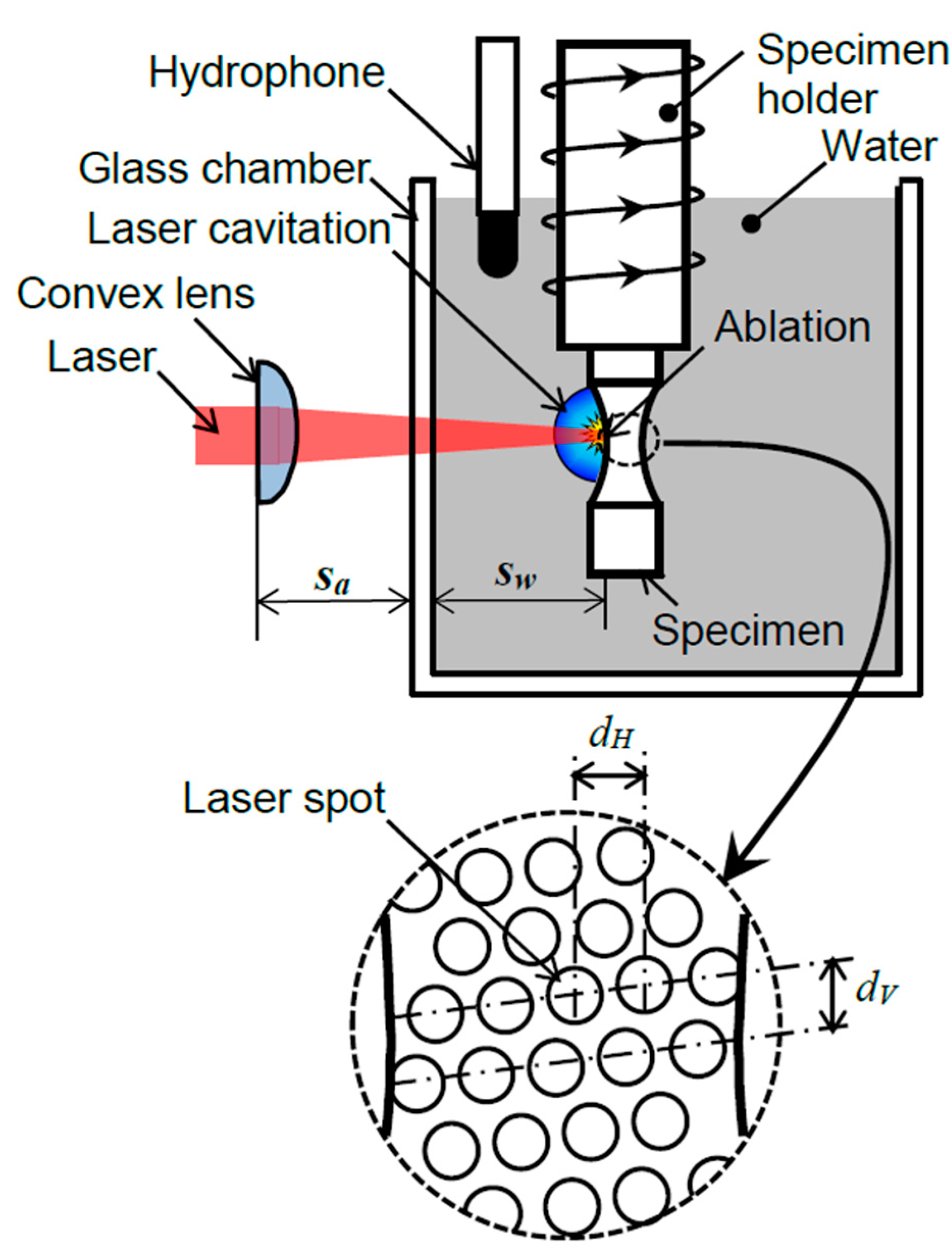
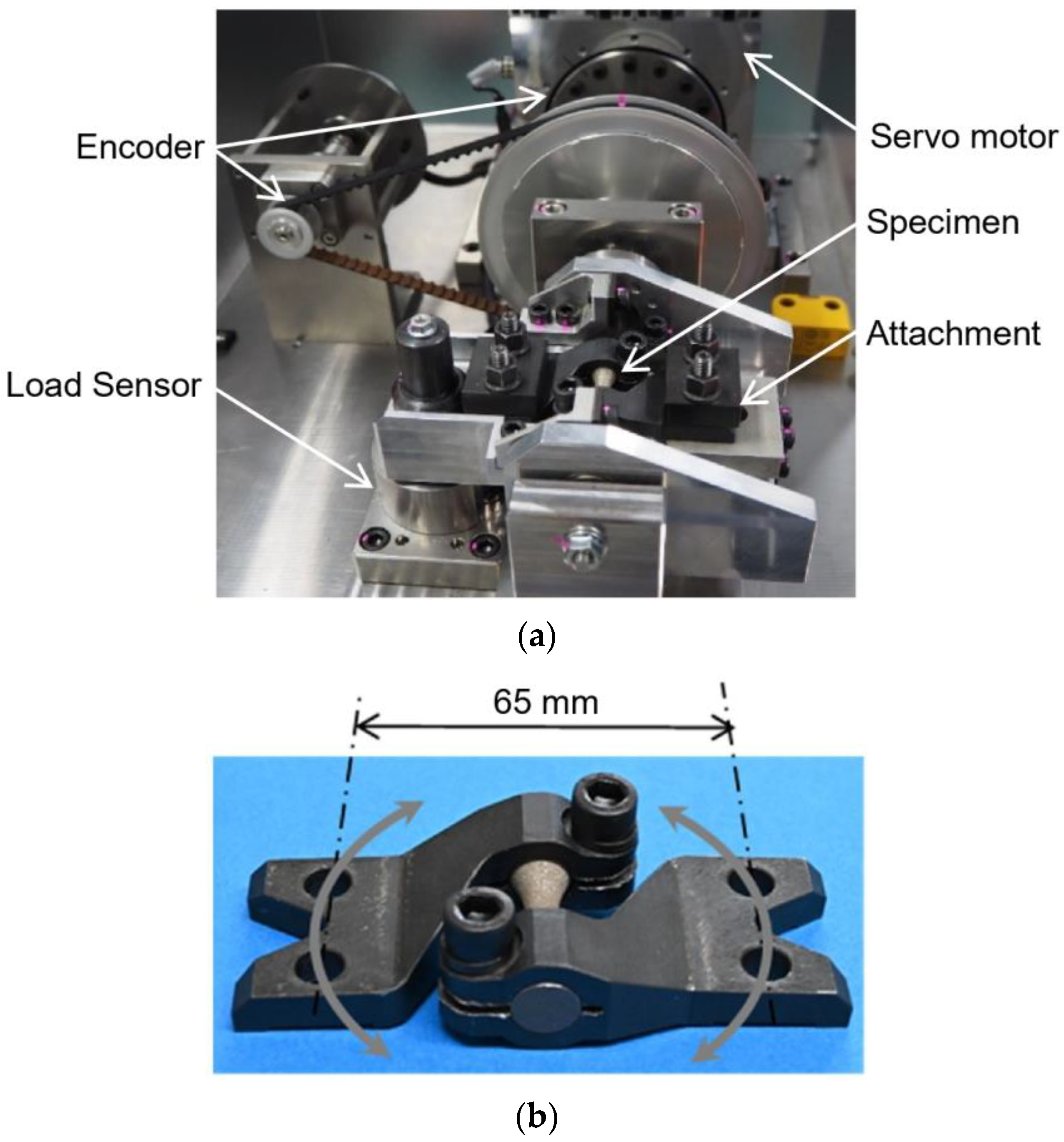



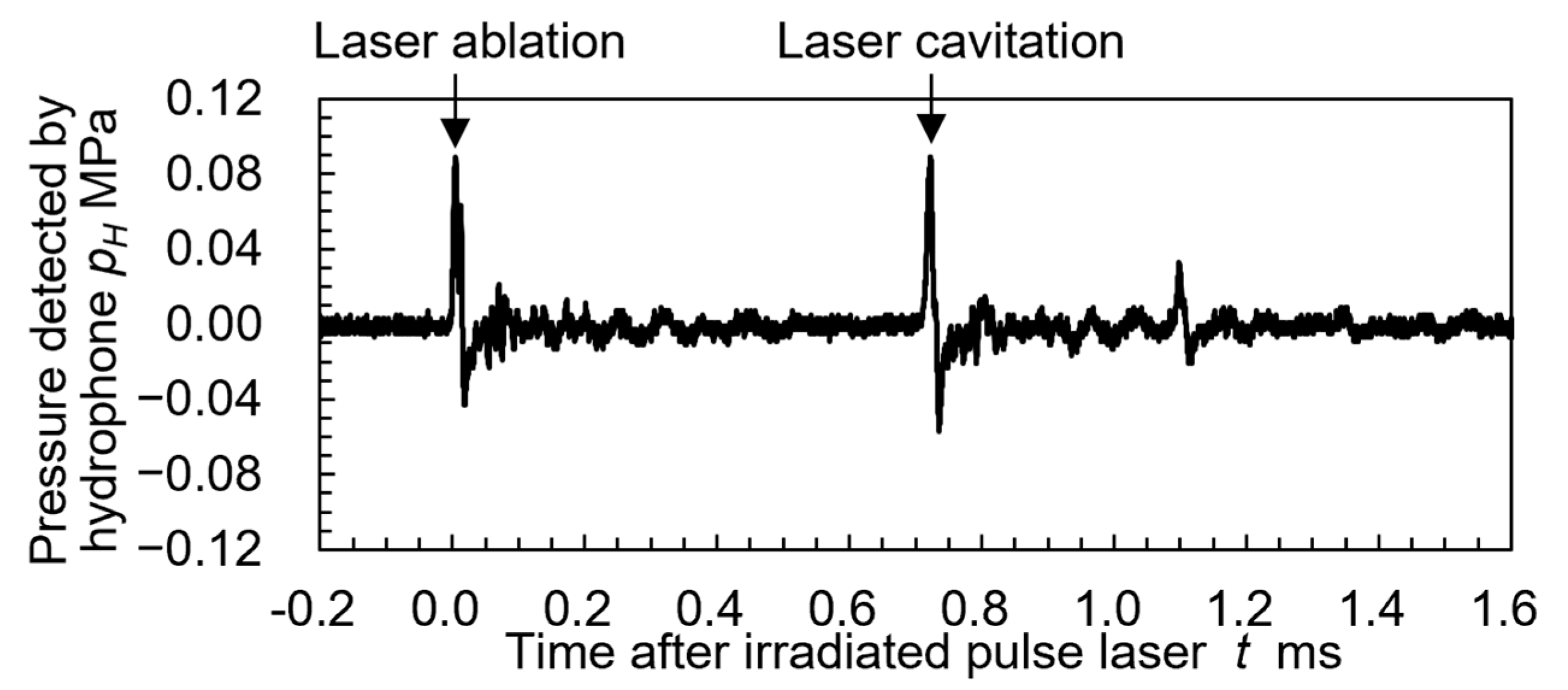
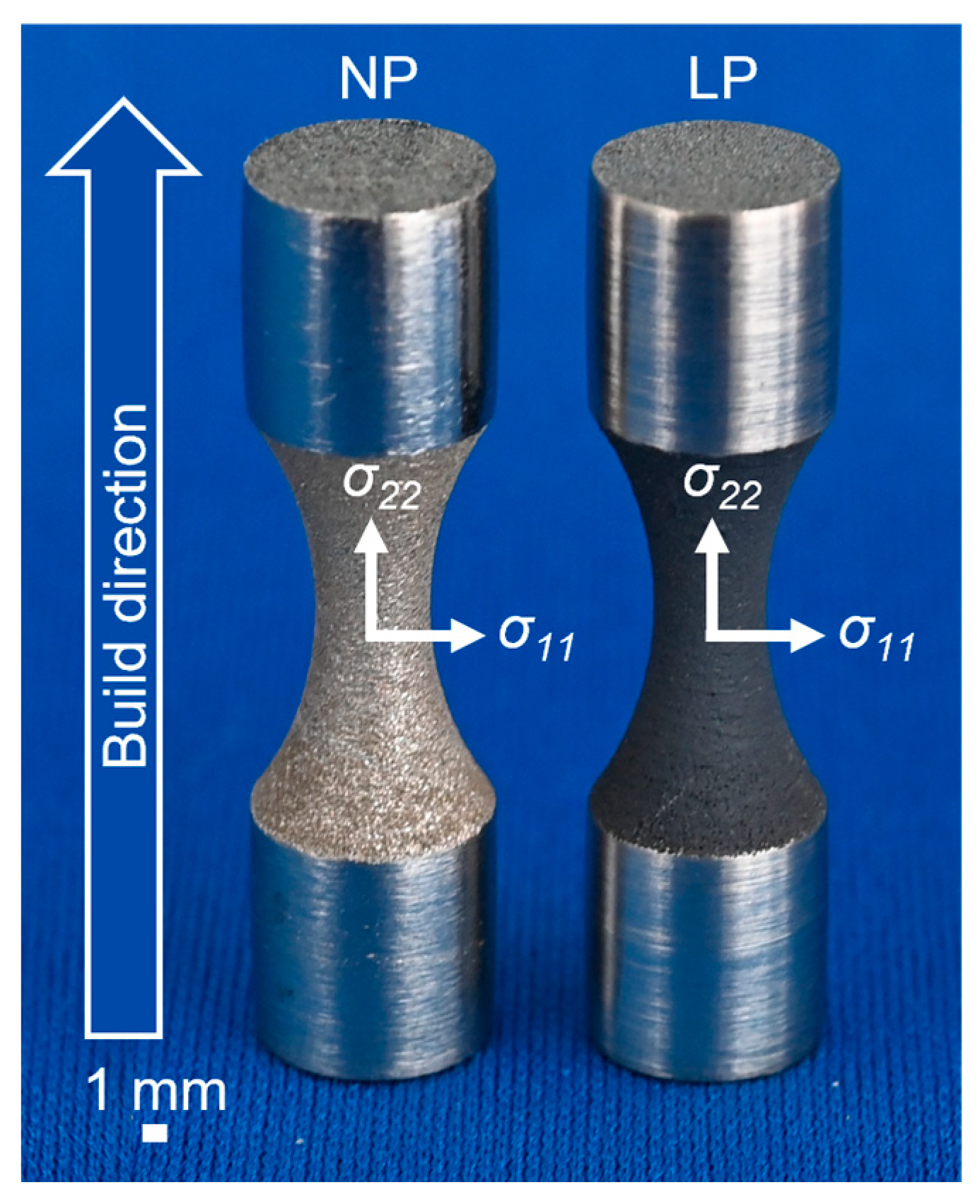


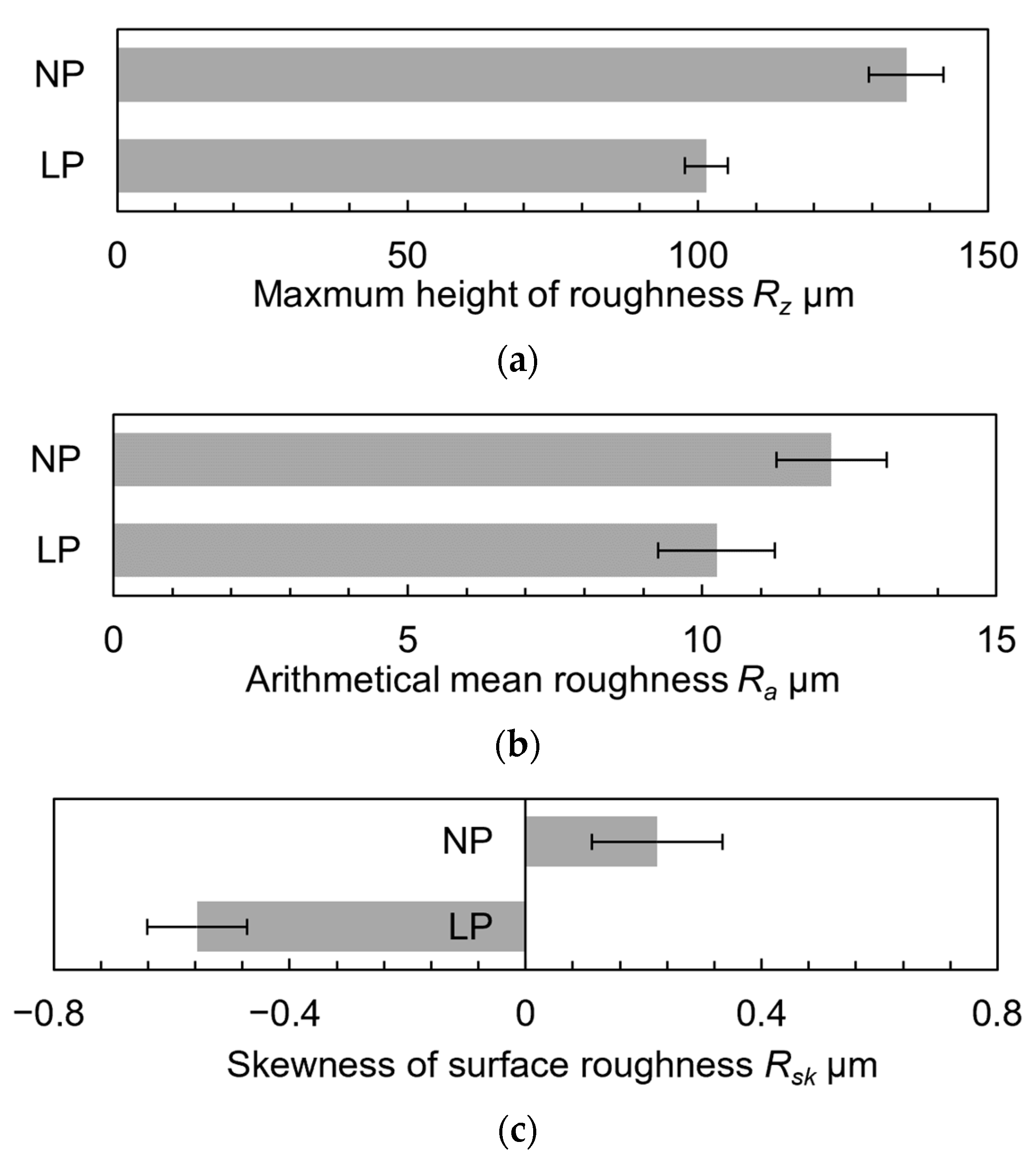



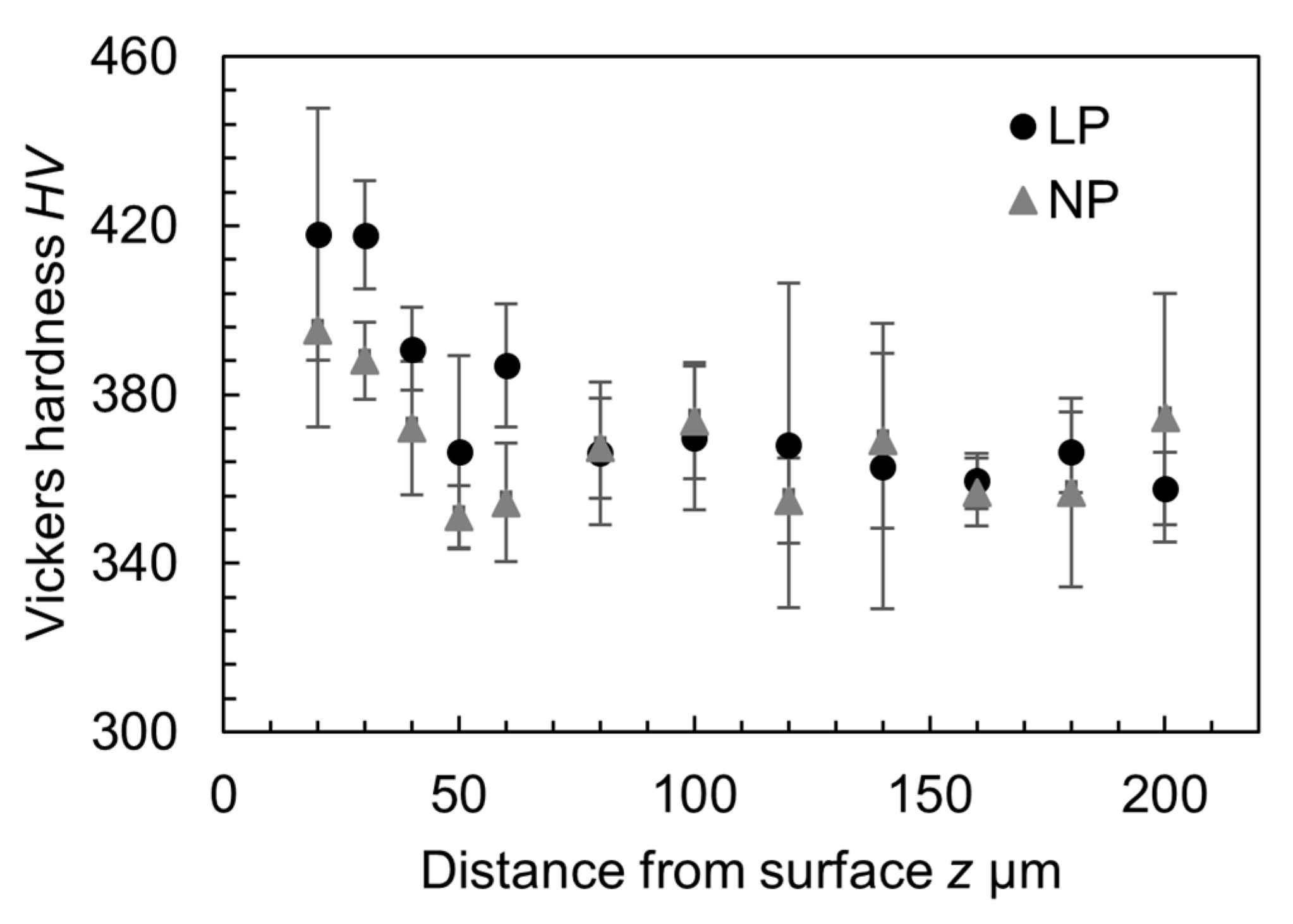


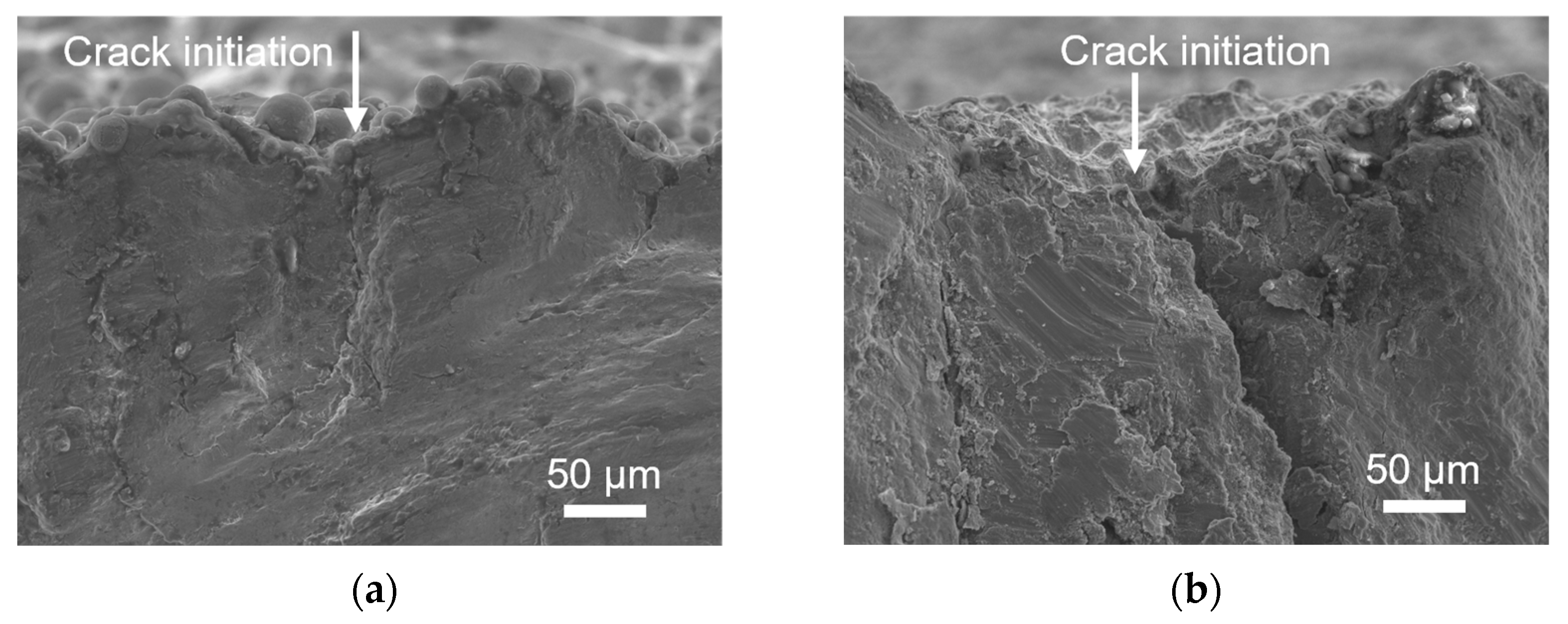
| Method | ψ° | φ° |
|---|---|---|
| 2D method | 0 | 0, 45, 90, 135, 180, 225, 270, 315 |
| 30 | 45, 90, 135, 180, 225, 270, 315 | |
| 60 | 90, 135, 180, 225, 270 |
| Sample Name | Surface Treatment Method | Surface Treatment Condition | Reference |
|---|---|---|---|
| NP (present study) | Non-peening | None | Present study |
| LP (present study) | Laser cavitation peening | Laser pulse density dL = 80 pulses/mm2 | Present study |
| NP | Non-peening | None | [27] |
| SP | Shot peening | Processing time per unit length tp = 5 s/mm | [27] |
| CP | Water cavitation peening | Processing time per unit length tp = 4 s/mm | [27] |
| LP | Laser cavitation peening | Laser pulse density dL = 80 pulses/mm2 | [27] |
Disclaimer/Publisher’s Note: The statements, opinions and data contained in all publications are solely those of the individual author(s) and contributor(s) and not of MDPI and/or the editor(s). MDPI and/or the editor(s) disclaim responsibility for any injury to people or property resulting from any ideas, methods, instructions or products referred to in the content. |
© 2023 by the authors. Licensee MDPI, Basel, Switzerland. This article is an open access article distributed under the terms and conditions of the Creative Commons Attribution (CC BY) license (https://creativecommons.org/licenses/by/4.0/).
Share and Cite
Kuji, C.; Soyama, H. Mechanical Surface Treatment of Titanium Alloy Ti6Al4V Manufactured by Direct Metal Laser Sintering Using Laser Cavitation. Metals 2023, 13, 181. https://doi.org/10.3390/met13010181
Kuji C, Soyama H. Mechanical Surface Treatment of Titanium Alloy Ti6Al4V Manufactured by Direct Metal Laser Sintering Using Laser Cavitation. Metals. 2023; 13(1):181. https://doi.org/10.3390/met13010181
Chicago/Turabian StyleKuji, Chieko, and Hitoshi Soyama. 2023. "Mechanical Surface Treatment of Titanium Alloy Ti6Al4V Manufactured by Direct Metal Laser Sintering Using Laser Cavitation" Metals 13, no. 1: 181. https://doi.org/10.3390/met13010181
APA StyleKuji, C., & Soyama, H. (2023). Mechanical Surface Treatment of Titanium Alloy Ti6Al4V Manufactured by Direct Metal Laser Sintering Using Laser Cavitation. Metals, 13(1), 181. https://doi.org/10.3390/met13010181






